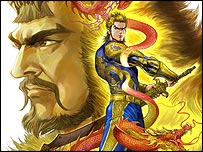Listen in as Alex Fitch at Panel Borders interviews the next generation of Chinese comic artists, whose pages are now on display as part of China Now, a six-month festival bringing Chinese culture to the UK. The free exhibit is on display at the London College of Communication through April 11.
Over 200 pieces from the last 25 years are being shown from China, Hong Kong and British-based Chinese artists in what organizers hope will reveal the “heart and soul” of contemporary China.
Podcast 1: Fitch talks to artist Yishan Li about her art, her love of the comics medium and her influences. Includes an introduction by curator Paul Gravett’s and tour of the opening room of the exhibition.
Podcast 2: Fitch talks to artists TH (Tim) Yu, Mr Clement and Jessica Potter from China Now
Podcast 3: Fitch hosts a round table discussion with Gravett and Hong Kong artists Chihoi Lee and Hok Tak Yeung.
Podcast 4: Fitch discusses the Beijing underground comics scene with creator and commentator Coco Wang.
Podcast 5: Fitch talks to artists Benjamin, Nie Chongrui and Zhang Xiaoyu via translator Coco Wang.
From China Comics Now:
To provide some context, the exhibition will outline Manhua’s roots in China’s picture story history and in particular the illustrated traditions since the 1920s of ‘Lianhuanhua’, or ‘linked pictures’, usually palm-size booklets of classical tales and ideological messages.
The two simplified Chinese characters for ‘Manhua’ are the same as those used in Japan for ‘Manga’ and mean essentially ‘humorous’ (Man) ‘drawings’ (Hua). Today the comics medium has proved to be a powerful vehicle of imagination, communication and expression, driven by vibrant visual sequences. The language of ‘Manhua’, modern Chinese comics, can bridge cultures and make the history, legends, fantasies and everyday lives of Chinese people today accessible to the widest public.
According to BBC News, while Chinese comics tend to be less controversial than Manga, many of the artists on exhibit are pushing against the state, which has long controlled Manhua as a propaganda tool:
One comic strip at the exhibition features two Godzilla-sized politicians embroiled in fisticuffs above the Hong Kong skyline, demolishing any buildings that stand in their way. Another features a misshapen man-child, his shaven head branded with a barcode, struggling to come to terms with modern working life. However, both of these comics were produced away from the Chinese mainland.
UK-based artist Coco Wang, who helped Gravett with the exhibit, says:
Government intervention in China is stifling the development of Manhua because artists find it so difficult to produce work that is both permissible to the authorities and interesting for the readers.
“The government is very sensitive to anything that is political, sexual or violent. So the underground artists have kept their distance from the Chinese publishers. All the underground comics are self-published.”
More from CDT on comics:
A Cartoon for China’s New Generation
Anti-graft Comic Book For Chinese Cadres
Cartoonist’s Social Spoofs Attract Young Chinese









